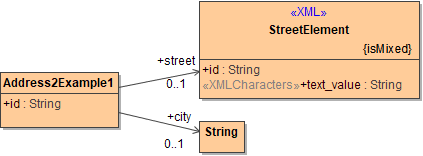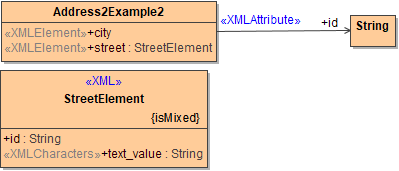Page History
...
| Tagged Value | Level | Description | Allowed Values | ||||||||||||||||||
|---|---|---|---|---|---|---|---|---|---|---|---|---|---|---|---|---|---|---|---|---|---|
| classToXMLDefaultRootName | Composite |
| Default |
| |||||||||||||||||
| Type Name |
| ||||||||||||||||||||
| Variable Name |
| ||||||||||||||||||||
| xmlNamespace | Class | Specify the XML namespace. | a valid namespace | ||||||||||||||||||
| xmlElementName | Class | Specify the name of the XML root element. | a valid element name | ||||||||||||||||||
| isMixed | Class | Specify whether the XML contains mixed (static and variable) content.attributes that are serialized as character stream (attributes with stereotype <<XMLCharacters>>, see also Controlling the Mapping by Stereotypes). | true | XML contains mixed contentserialized attributes. | |||||||||||||||||
| false | XML does not contain mixed content contain serialized attributes (default). | ||||||||||||||||||||
| isOrdered | Class | Specify whether the class attributes should be serialized to XML using the order tag that has been specified on the attributes. | true | Serialize in order of order tags from the attributes. | |||||||||||||||||
| false | Serialize in order of attributes on class. | ||||||||||||||||||||
| xmlNamespace | Attribute | Each XML attribute and element may have its own namespace. If the tagged value contains an URI, the runtime will automatically generate a unique prefix. For exampleExample: A tagged value xmlNamespace = "http://e2e.ch" on the UML property anElement will result in the XML document tagged value xmlNamespace = 'xmlns:typens="http://e2e.ch"' of the UML property anElement will lead to the following XML fragment: | an URI | ||||||||||||||||||
| a valid xlmns syntax | |||||||||||||||||||||
| xmlForm | Attribute | Depending on this tagged value, XML elements or attributes may not be qualified by a namespace prefix even if they have one. | qualified | The element or attribute must always be qualified by a namespace prefix. Default for XML elements. | |||||||||||||||||
| unqualified | No namespace prefixes are allowed (for details see http://www.w3.org/TR/xmlschema-0/#NS). Default for XML attributes. | ||||||||||||||||||||
| xmlFormat | Attribute | If numbers and date/time types are parsed or composed, the XML parser respectively composer expects simple date types following the XML schema specification. However, legacy XML documents may contain different number and date/time formats. In this case, the tagged value xmlFormat may hold a format string. If numbers are parsed or composed use the format strings defined in section Number Formatting. If date/time expressions must be parsed or composed, use the format strings defined in Date and Time Formatting. Use xmlFormat = "CDATA" together with stereotype <<XMLElement>> to compose strings as CDATA with classToXML() . Parse CDATA elements works out of the box, you do not need to set xmlFormat. | a valid format string (see Number Formatting or Date and Time Formatting) | ||||||||||||||||||
| CDATA | compose string as CDATA | ||||||||||||||||||||
| isNillable | Attribute | By default, UML properties that are NULL are not serialized into XML documents. However, if it is necessary to do so, isNillable must be set to true. In this case, the UML properties being NULL will look like:
| true | serialize NULL properties | |||||||||||||||||
| false (default) | do not serialize NULL properties | ||||||||||||||||||||
| order | Attribute | Use this tagged value of <<E2EAttribute>> to specify the order in which the XML elements will be generated to the XML document. | a valid float | ||||||||||||||||||
...
The following table shows the behavior of XML serialization for the examplefollowing class containing an array:
| Code Block |
|---|
{
"aClass" : { "anArray" : ["A1", "A2", "A3"] };
} |
| Description | XML result | |||||
|---|---|---|---|---|---|---|
| All values are present. |
| |||||
| The second value (A2) is NULL and isNillable=false. |
| |||||
| The second value (A2) is NULL and isNillable=true |
| |||||
| The array is NULL. |
| |||||
| The array is empty. |
| |||||
| All elements are NULL and isNillable=false. |
| |||||
| All elements are NULL and isNillable=true. |
| |||||
| classToXMLDefaultRootName="Default" and xmlElementName="anotherClass". |
| |||||
| classToXMLDefaultRootName="Type Name" and xmlElementName="anotherClass". |
| |||||
| classToXMLDefaultRootName="Variable Name" and xmlElementName="anotherClass". |
|
Examples
| Multiexcerpt include | ||||||
|---|---|---|---|---|---|---|
|
The following example shows how to convert Suppose an XML data structure contains elements with attribute values (in the example below these are street and city ), and you want to convert them to with mixed content to an UML class.
| Info | ||
|---|---|---|
| ||
If an XML element has attributes, this is called mixed content in Bridge context. |
Suppose the following XML data structure with two elements street and city is given:
| Code Block | ||||
|---|---|---|---|---|
| ||||
<address id="myAddress4711"> <street id="234">Lautengartenstr. 12<4711-1">13, Coal Street</street> <city id="34">Basel<4711-2">New York, NY 10017, USA</city> </address> |
The class diagram below illustrates how to map the content of the XML element street ("Lautengartenstr. 1213, Coal Street") and the value of its attribute id ("2344711-1") to the UML association end street:
Figure: Mapping XML Data Structures to UML Classes
a class structure:
To map XML element street and its attribute id, you need a dedicated class as a container. In this example, this is class StreetElement. XML attribute id of The street element from the above XML example is mapped to the association end street. The association end name must be the same as the name of the XML element. The associated class StreetElement is only a container for the street element. The name of the class is not relevant for the mapping. The XML attribute id of the element street is mapped to the class attribute id of the UML class StreetElement via matching names. The content of the XML element street is mapped to the class attribute text_value, which has the stereotype <<XMLCharacters>>that has stereotype <<XMLCharacters>>. In this example this is text_value.
Class StreetElement must have stereotype <<XML>> and tagged value isMixed set to true because it contains the serialized attribute text_value (also see explanation of tagged value isMixed).
Containter StreetElement is associated to the main address class. The name of the association end (street) must match the name of the XML element. Associated class StreetElement is only a container for the street element and its name is not relevant for the mapping.
If the XML element contains attributes, which should not be mapped to UML class attributes, an association to a base type can be used. The following example shows this for the element city. The content of the element ("BaselNew York, NY 10017, USA") will be available in city (accessible as attribute of the instantiated class Address2Example1). As the id attribute cannot be mapped, it will be discarded when executing the operation xmlToClass().
Figure: Preventing the Mapping of XML Attributes
Below, find the complete class diagram used for mapping the XML document address.xml.
Figure: Example when Using Operation xmlToClass()
...
If an object of class Address2Example1 were was serialized back in a SOAP response, the SOAP message would read:
| Code Block | ||||
|---|---|---|---|---|
| ||||
<address2Example1 xmlns:ns1="urn:Services.URLService.URLPort.DataItems" xsi:type="ns1:Address2Example1">
<id xsi:type="xsd:string">34<>4711</id>
<street xsi:type="ns1:StreetElement">
<id xsi:type="xsd:string">234<>4711-1</id>
<text_value xsi:type="xsd:string">Lautengartenstr. 12
<>13, Coal Street</text_value>
</street>
<city xsi:type="xsd:string">Basel<>New York, NY 10017, USA</city>
</address2Example1> |
The same result could be obtained with the following class diagram.
...
:
...
With the three XML stereotypes, one has the You have the flexibility to map XML structures in different ways. You can define very compact class diagrams for simple XML structures, but you have also the possibility to map complex XML data structures graphically.
| Info | ||
|---|---|---|
| ||
If an XML Schema is provided, you can import it with the Builder. It will generate all classes and relations according the XSD import rules described in XML Schema Import Rules. For how to use the E2E XSD Importer refer to Importing WSDL or XSD. |


